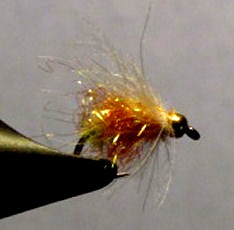
On The Fly
February 2016
"Fly tying is a school from which we never graduate"
TYING NEWS
The Southern Oregon Fly Tyers invite you to attend their meetings the second Tuesday
of each month. The next meeting is Febraury 9, 2016. The meetings start at 6:00 PM, at the Madrone Hill Mobile
Home Park community building near Gold Hill. Bring a friend, come early so you don't miss anything, and
stay late. Tyers need not be experienced, and those with all levels of skill are welcome. Each meeting a
member is encouraged to demonstrate a new or different skill, from simple to difficult. For more
information, call Dan Kellogg at 773-4724.
DIRECTIONS: Take Gold Hill Exit #40, off of I-5 and go west, toward Jacksonville, 1.3
miles, until you reach the brick entrance way to the Madrone Hill Mobile Home Park on the right. You’ll
pass a golf course parking lot on your left shortly after leaving the freeway. After you turn right into
the mobile home park, proceed to the community building which is located about 100 yards ahead on the left.
The address is 8401 Old Stage Rd.
 PATTERN OF THE MONTH - Ice Dub Egg
PATTERN OF THE MONTH - Ice Dub Egg
Hook: #10 egg - D1120, U 202
Thread: orange
Bead: 5/64" gold - brass or tungsten
Wire: .015 lead
Egg sac: chartreuse chenille or dubbing - sparkle OK
Abdomen: hot or burnt orange dubbing or ice dubbing
Hackle: 2 wraps of white CDC - this is optional, but I am a fan of CDC.
Tying Instructions:
1) Pinch down hook barb and slip the bead on, small hole first. I usually make 2 or 3 wraps of .015 lead onto the hook and slide it into the bead. And then
add a tiny drop of super glue. The lead provides more surface for the glue to adhere to. Check to be sure the glue doesn’t seep out to the hook eye! As soon
as the glue comes out, tip the hook eye upward. The glue is optional but this beginner finds that it stabilizes the bead while I wrap the rest of the fly.
2)Make a thread dam behind the lead wire as the glue will eventually soften in the water. (Gorilla super glue is said to be the most waterproof, but I don’t
know). Then wrap the thread back to the bend.
3)Strip about c” of fuzz off the chenille, tie it down and take the thread forward a few wraps. Make 2 or 3 wraps of the chenille forward for the egg sac, tie
it down and snip the excess. You want the egg sack to be visible but small but small compared to the abdomen.
4)Make a 3" dubbing loop and run the thread up to the lead wire - let it hang. I find ice dub easier to handle after a swipe of wax on one side of the loop.
Form a generous string of dubbing, center it in the loop and spin it with your whirler until the strands stand out. Wrap the dubbing up to the bead area,
forming a rather large oval abdomen as you go. The abdomen should be noticeably bigger than the egg sac. Stroke the dubbing back as you tie it down to make a
little room for tying in the CDC.
5)Tie in a white CDC feather by the tip, make 2 wraps and tie down. Do a couple or 3- or 4-wrap whips and you are done!
RFF member Steve Day shared this pattern with me, for which I am most grateful. Tie some up and you will be, too! Fish it about two feet below your stone fly.
Steve says it can be tied in other colors as well, such as pale yellow, apricot, oranges and red. Good luck!
See http://oregonflyfishingblog.com/2010/01/21/killer-winter-steelhead-egg-pattern-the-lifter/ for a similar pattern using white sparkle emerger yarn instead
of CDC.
Jon Iverson